Night Toothache Relief: Easy Drug-Free Solutions That Actually Help
So, how does tooth loss affect speech? In this article, we will examine in detail the effects of tooth loss…
These implants are significantly longer than standard implants and are used in cases where bone grafting or sinus lift procedures may not be viable or preferred. The zygomatic bone provides an excellent foundation because of its dense structure, allowing for the secure placement of the implant, even when the jawbone itself is insufficient for traditional dental implants.
Choose Your Topics
Before the procedure begins, the patient undergoes a thorough examination, including digital X-rays, 3D scans, and a clinical assessment to determine the suitability of the zygomatic implants. This phase allows the dentist to create a detailed treatment plan and pinpoint the exact placement of the implants.
Because zygomatic implant placement is a surgical procedure, patients are typically sedated using either general anesthesia or IV sedation. This ensures that the patient feels no discomfort during the surgery.
Zygomatic implants represent a unique category of dental implants specifically created for individuals with insufficient bone density in the upper jaw. Unlike standard implants that are directly placed into the jawbone, these implants are secured in the zygomatic bone, often referred to as the cheekbone. The surgeon carefully drills the implant into this bone, ensuring precise positioning to avoid complications with surrounding structures such as the sinus cavities.
After the implants are placed, a temporary prosthesis is fixed in place. This enables the patient to have functional teeth during the healing phase as the implants fuse with the bone.
In the subsequent 3 to 6 months, the implants experience osseointegration, a process in which they merge with the adjacent bone tissue. This establishes a stable base for the permanent prosthesis, ensuring lasting support for the patient's new teeth.
After the healing process is finished, the temporary prosthesis is swapped out for a custom-made permanent prosthetic that closely resembles the patient's natural teeth in both appearance and functionality.
You can contact us here to learn more about Cosmetic Dentistry, Dental Crown, Dental Implant and General Dentistry to make an appointment and to get information about our services.
Severe bone loss can disqualify patients from receiving traditional implants, particularly if it results from extended tooth loss or periodontal disease. However, zygomatic implants provide a solution by eliminating the necessity for extra bone grafting procedures.
Some individuals may not be suitable candidates for bone grafting due to medical conditions or a desire to avoid invasive procedures. Zygomatic implants remove the need for bone grafting interventions.
Patients who are missing most or all of their upper teeth and require a full-arch solution may benefit from zygomatic implants as they can support a full prosthetic set.
In cases where traditional implants would interfere with the sinus cavities, zygomatic implants provide an alternative as they are anchored in the cheekbone.
Zygomatic implants offer various advantages, especially for individuals who are unable to choose traditional implants because of significant bone loss. One of the major advantages is that they eliminate the need for bone grafts, a common requirement for patients with insufficient jawbone density.
This makes the procedure less invasive and shortens the overall treatment time. Another benefit is the immediate functionality they provide. In many cases, patients can have a temporary prosthesis placed the same day as the surgery, allowing them to leave the clinic with functional teeth, which greatly improves both appearance and quality of life during recovery.
Zygomatic implants also have high success rates, especially when performed by experienced professionals. The strong zygomatic bone serves as a stable foundation for the implants, ensuring long-term durability and success. Additionally, because the procedure skips the need for bone grafts, the overall treatment timeline is faster, allowing patients to receive their permanent teeth sooner.
For individuals experiencing significant bone loss and who cannot undergo traditional implants, zygomatic implants present a practical solution. This solution allows many individuals who would otherwise rely on dentures to benefit from fixed, permanent teeth.


Before undergoing zygomatic implant surgery, patients should carefully consider a few important factors. First, choosing a highly skilled and experienced surgeon is essential, as zygomatic implants require advanced techniques. Patients should seek a board-certified oral surgeon who has a strong history of successful procedures.
It’s essential to inform the dentist of any medical conditions, such as diabetes or heart disease, as these can impact the healing process. Furthermore, smoking should be taken into account, as it can elevate the chances of implant failure. Patients must also adhere to pre-surgical guidelines, which may include fasting before anesthesia and organizing transportation home post-procedure.
The recovery period following zygomatic implant surgery plays a vital role in ensuring the long-term success of the procedure. While the implants provide instant stability, the recovery phase may extend over several months. During the initial week following the surgery, patients might experience swelling, bruising, and mild discomfort.
To manage pain, over-the-counter or prescribed medications are typically recommended. During this time, it is crucial to take it easy and avoid vigorous activities to minimize the likelihood of complications. Dietary adjustments are also essential during the recovery phase. Soft foods are advised to prevent putting pressure on the implant site, and patients should avoid chewing directly over the implants.
Foods that are tough or sticky can disrupt the healing process and should be avoided. The osseointegration process, where the implant bonds with the bone, is crucial for the implants' stability and usually takes several months to complete. During this time, it’s essential for patients to attend follow-up appointments to track healing progress and uphold good oral hygiene. Proper care during this period is crucial to prevent infections and lower the risk of implant failure.


The price of zygomatic implants can fluctuate based on various elements, such as the intricacy of the procedure, the quantity of implants needed, the materials utilized, and the surgeon’s skill level. Generally, zygomatic implants are pricier than conventional implants because of the sophisticated surgical methods involved and their extended length.
Additionally, other factors such as the geographical location of the dental clinic and the use of high-quality prosthetics can influence the overall price. Certain dental clinics provide financing alternatives to make the procedure more accessible. Patients are advised to have conversations about the expenses with their dental care provider and consider payment plans if necessary.
The zygomatic bone, or cheekbone, is a key part of the midface structure. It constitutes a portion of the eye socket and is linked to the maxilla, which supports the upper teeth. In dentistry, the zygomatic bone is significant as it provides a strong area for zygomatic implants, allowing for effective restoration in patients with insufficient jawbone density.
Zygomatic implants are typically safe when conducted by a skilled oral surgeon.. While potential risks like infection or nerve damage exist, they are rare. A comprehensive assessment prior to surgery is crucial in establishing candidacy, and adhering to post-operative care guidelines can significantly reduce the risk of complications.
Zygomatic implant surgery is more complex than traditional implant procedures due to the zygomatic bone's anatomy. It requires advanced surgical skills, but for experienced surgeons, the procedure is manageable. Patients often find recovery similar to that of traditional implants, making it essential to choose a skilled specialist for the best outcomes.
Zygomatic implants are specifically intended for the upper jaw and cannot be placed in the lower jaw. For the lower jaw, traditional implants or other methods like bone grafting are used based on the patient's bone structure and condition.
So, how does tooth loss affect speech? In this article, we will examine in detail the effects of tooth loss…
So, how does tooth loss affect speech? In this article, we will examine in detail the effects of tooth loss…
So, how does tooth loss affect speech? In this article, we will examine in detail the effects of tooth loss…

Special Note:
Our treatments are provided by healthcare facilities that possess a health tourism authorization certificate

Special Note: Our treatments are provided by healthcare facilities that possess a health tourism authorization certificate
Selenium Retro, Ataköy 7-8-9-10. Kısım, D-100 Güney Yanyolu No:18/A, 34158 Bakırköy/İstanbul
© 2025, LYGOS DENTAL. All Rights Reserved.